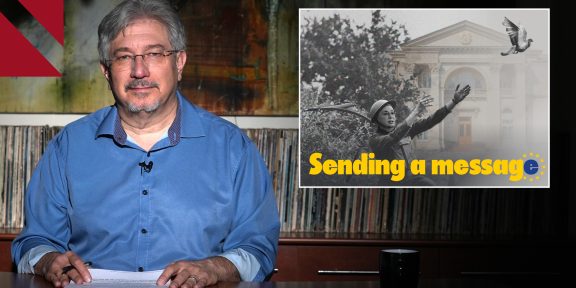 The Cafesjian Center for the Arts, also known as the Cascades, is perhaps the most recognized Yerevan landmark. Since its grand opening in 2009, the center has been committed to bringing international contemporary art to Armenia while showcasing Armenian contemporary art to the world.
The Cafesjian Center for the Arts, also known as the Cascades, is perhaps the most recognized Yerevan landmark. Since its grand opening in 2009, the center has been committed to bringing international contemporary art to Armenia while showcasing Armenian contemporary art to the world.
The current exhibition, “Crossroads,” is a collection of work by Armenian-Iranian artist Marcos Grigorian. It will be on display until August 28.
“Crossroads” is the first major exhibition of Marcos Grigorian’s work in Armenia since his death in 2007. The title is meant to encapsulate both style and form of Grigorian’s art. In the exhibition catalog, Director of Exhibitions Armen Yesayants writes, “Marcos Grigorian’s art, just like his personality, stands in such a cultural crossroad, where East crosses with the West, soil meets canvas, and the Persian carpet depicts images from the ancient Armenian kingdom.”
While some of the works in the exhibition are on loan from private collections and other museums, most of the work comes from Yerevan’s Middle East Art Museum, which opened in 1993 with a collection donated by Grigorian.
ABOUT MARCOS GRIGORIAN
Marcos Grigorian was a citizen of the world, born in Russia, raised in Iran, and educated in Italy. He lived in several different countries, including the United States, and eventually settled in Armenia later in life.
Grigorian’s contribution to contemporary art is extensive, both in his medium range and in his efforts in cultivating art spaces. In 1954, he opened Gallery Esthetique, one of the first modern galleries in Tehran, introducing Iranian audiences to coffeehouse painting. In 1958, he was a founder and organizer for the first Tehran-Venice Biennale, reinforcing his significance in Iranian contemporary art.
Outside of Iran, Grigorian established the Gorky Gallery in New York City, and in 1992, he founded the Middle East Art Museum (also called the Near East Museum) by contributing artwork from his private collection.
 “Rebirth,” 1991, Mud on Canvas. On loan from Middle East Art Museum.
“Rebirth,” 1991, Mud on Canvas. On loan from Middle East Art Museum.
Grigorian gained international recognition as an artist in the 1960s for his earthworks. Using soil, mud, straw, and other organic materials, Grigorian reminds us of the human connection to the ground beneath our feet, as well as our connection to the ash and dust of our mortality.
Grigorian’s earthworks began with his Holocaust series. 1n 1959, Grigorian completed a series of 12 canvases titled “The Gate of Auschwitz.” In 1960, Grigorian completed a 13th canvas using earth and ashes, symbolizing the beginning and the end of a human life, and introducing earth as a medium in his works.
 “The Gate of Aushwitz,” 1 of 13 canvases. 1959, Gouache, Pencil on Canvas. On loan from Middle East Art Museum. “Crossroads” displays two canvases from the series. Grigorian referred to the entire set as “a 120-feet-long cry of horror.” Critics have suggested the subject of the Holocaust may be an allusion to the pain of the Armenian Genocide.
“The Gate of Aushwitz,” 1 of 13 canvases. 1959, Gouache, Pencil on Canvas. On loan from Middle East Art Museum. “Crossroads” displays two canvases from the series. Grigorian referred to the entire set as “a 120-feet-long cry of horror.” Critics have suggested the subject of the Holocaust may be an allusion to the pain of the Armenian Genocide.
Unlike many other artists who use earth and organic materials, Yesayants points out that Grigorian brings land to the museum and into the art, instead of taking art to the land.
Grigorian’s dedication to the arts was multi-disciplinary. In addition to his experiments with earthworks, Grigorian was also an actor, a performance artist, and a carpet-maker. According to art historian Manya Ghazarian, “Marcos Grigorian’s involvement with earth work had led him to investigate the sources of art of the Araratian kingdom (Urartu) and, even more deeply, the petroglyphs which had progressed greatly in the Armenian plateau.” He then began to use these images in carpets.
Grigorian breaks many of the traditional Armenian and Iranian rules of carpet-making. “He understood the identical principles of Persian and Armenian carpets,” Ghazarian said. “His knowledge of carpet making enabled him to understand the principles of the formation of the ornamentation of Oriental carpets: understand but not to duplicate.”
Grigorian himself said, “Armenian carpets need new designs, as we have duplicated the past in carpets.”
Grigorian’s contemporary carpets could be said to transcend national traditions of carpet-making. As Ghazarian argued, his carpet work “is not limited to one nationality. It is based on the world views of various Oriental peoples and passes through the prism of the latest contemporary art forms, preserving and confirming the absolute truth that there exists a link between cultures of all times.”
Grigorian’s art can be found in the Museum of Modern Art (MoMA), the Metropolitan Museum of Art, the Tate Modern, the British Museum, the Tehran Museum of Contemporary Art, and the Empress Farah Pahlavi’s and Nelson Rockefeller’s collections.
 “Gazelles,” 1956/1992, Cotton, wool. On loan from the Middle East Art Museum.
“Gazelles,” 1956/1992, Cotton, wool. On loan from the Middle East Art Museum.
 “Golden Bird,” 1960/1992, Cotton, Wool. On loan from the Middle East Art Museum.
“Golden Bird,” 1960/1992, Cotton, Wool. On loan from the Middle East Art Museum.
 “Ara and Shamiram,” 1956/1992, Cotton, wool. On loan from the Middle East Art Museum.
“Ara and Shamiram,” 1956/1992, Cotton, wool. On loan from the Middle East Art Museum.
ABOUT THE MUSEUM
The Cafesjian Center for the Arts is committed to a range of artistic endeavors. While its permanent collection consists mostly of sculptural work and glass works, it also includes furniture, illustrations and murals, and more. It also hosts several visual art exhibitions during the year and provides a venue for music performances, lectures, and literary events.
 Three Glassinators, 2011 Andrew Carson (b. 1962) glass, aluminum, steel.
Three Glassinators, 2011 Andrew Carson (b. 1962) glass, aluminum, steel.
Envisioned in the early part of the 20th-century as an artistic center and promenade connecting the northern residential area to the cultural center of Yerevan, the project was delayed until the 1970s. Another delay occurred in 1988 after the earthquake. The project was once again revitalized when Armenian-American legal publisher Gerard Leon Cafesjian began the Cafesjian Family Foundation, Museum Foundation, and Center for the Arts, which was opened in 2009, as part of Cafesjian’s efforts to revitalize Armenia.
The Center’s collection comprises work by internationally-recognized twentieth- and twenty-first-century artists. The majority of the collection was donated from Cafesjian’s personal collection, and it contains more than 5,000 works. The sculpture yard in front of the museum includes several sculptures by Colombian artist Fernando Botero, known for his large, exaggerated figures, and Welsh sculptor Barry Flanagan, known for his bronze hare sculptures.
The Center also holds work by Arshile Gorky, Marc Chagall, and Czech glass artists Stanislav Libenský and Jaroslava Brychtová.
Text and photos by Heather Momyer
WHAT’S NEXT
The center hosts regular concerts, lectures, and educational events. Details can be found on their website or Facebook page.
New exhibitions will open in September and October, though Yesayants said the details must be a surprise.
 “Sculpture Chair,” 20th century by Hally Olivetti, colored plastic
“Sculpture Chair,” 20th century by Hally Olivetti, colored plastic
“African Beadwork ‘Fan’ Armchair,” by Yoruba, glass beads, fabric wood
ADDRESS: 10 Tamanyan Street, Yerevan
HOURS: Tuesdays – Thursdays: 10:00 AM – 5:00 PM
Fridays – Sundays: 10:00 AM – 8:00 PM
ADMISSION FEES:
Gallery One FREE
Museum Store
Khanjyan Gallery
Swarovski Crystal Palace
Exhibition Halls:
Members FREE
Adults 1,000 drams
 Fernando Botero, “Woman Smoking a Cigarette.
Fernando Botero, “Woman Smoking a Cigarette.
Seniors 800 drams
Youth 13–17 750 drams
Children (aged up to 12) FREE
WEBPAGE: http://www.cmf.am
FACEBOOK: https://www.facebook.com/cafesjiancentercascade
INFORMATION ON MIDDLE EAST ART MUSEUM
ADDRESS: 1 Aram Street, Yerevan
(Shared with the Museum of Literature and Art, in the same building as the National Gallery)

















